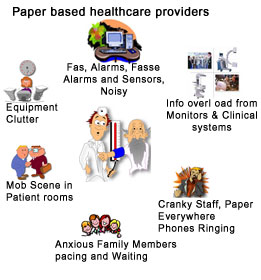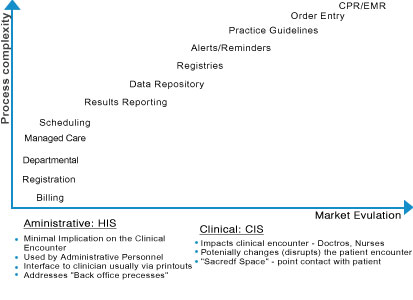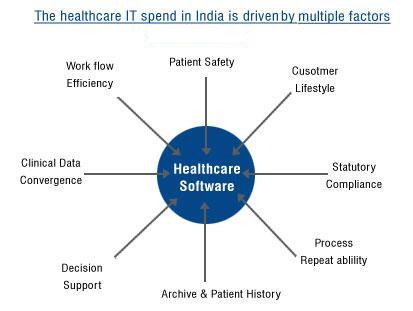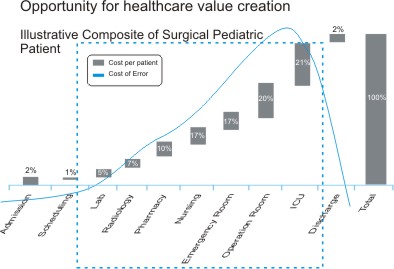Healthcare IT
 Background
Background
Absence of formal integrated processes
- Fire-fighting attitude
- Ad hoc decision making at patient-point-of contact
- Sub optimal planning lead to bottlenecks and idle capacity
- Inefficient and repetitive activities
- Fragmented care process
- Long waiting time
- Patient and attendant anxiety
- Low patient safety levels

Paper based transactions
- Incomplete, unavailable, inadequate, inaccurate clinical information
- Doctor's time involved in documentation
- Same prognosis manually written for ~75% of the patients Information overload from monitors and equipments
- Cluttered data limit leveraging full capability of equipments
- Mob scene in patient rooms
- Manual consolidation and analysis of clinical findings
- Loss of data and medical history
- Extensive filing for imagery and historic trend analysis
- Non-standardized treatment
- Of the memory- off the memory
Doctors in administrative roles
- Unreliable support staff with poor patient confidence
- Repetitive documentation and reporting
- Stressful decision making for scheduling, admission, emergency handling
- Handling end to end patient cycle from appointment to billing
- Legal and insurance formalities for record keeping Unreliable data on 'doctor profitability'
- Poor control over junior doctors
This typically leads to over-worked doctors, confused nurses and poor patient health
Overall, the Indian healthcare delivery is a strong candidate for IT backed process improvement. Significant benefits can be achieved by streamlining activities, redesigning workflows and institutionalizing processes across the hospital. The process design has to take an integrated hospital view- rather than myopically optimizing departments and functions
Globally, IT adoption and implementation of hospital-wide software systems is an accepted solution to roll out efficient and standardized processes.
Asclepius adopts this holistic approach at IT implementation to study the processes, offer management consulting and process changes and supports these recommendations with suitable IT solutions
Healthcare IT
Globally most of the healthcare software services can be broadly categorized into HIS (Hospital Information System) CIS (Clinical Information System) and other ancillary or department system.
- HIS Hospital information systems cater to all activities for a hospital - which can typically be carried out with the intervention of a doctor. Typically, activities like scheduling, registration, billing, etc. are categorized as HIS. HIS software has minimal implication to the clinical encounter and is used by hospital administrative personnel addressing the back office processes. The interface with the clinicians is typically through printouts
- CIS Clinical information system (CIS), on the other hand, spans all the activities which impact the clinical encounter- doctors/ nurses - regarded by doctors as the 'sacred space'. All elements of patient care- recording vital signs, observing symptoms, investigative reports through labs and radiology, diagnosis, prognosis, treatment plan, inpatient monitoring and medicine administering, discharge and follow up- are all under the purview of clinical information centers

Click thumbnail for enlarged view
Ancillary or departmental systems like LIS (Laboratory Information System) and RIS (Radiology Information System)/PACS (Picture Archival and Communication System) cater to specific workflows; which however interface with a core Clinical Information System (CIS).
Increasingly CIS is also leveraged to interface with myriad medical devices and equipments- to avoid the inaccuracies associated with paper work and manual data capture. Globally, CIS offers and end to end healthcare solution integrated with hospital administration, diagnosis, laboratory, imaging systems, care plan and medical devices
Healthcare IT market
Globally the top 100 healthcare IT providers garner more than $ 24 billion in IT products and services in 2005, offering everything from highly specialized best-of-breed applications to comprehensive enterprise-wide solutions. Overall, the industry has shown strong growth and is still considered to be 'under penetrated'.
In India, the CIS products are limited to select high end organized hospital chains- aiming at standardizing services and IT enabling clinical interactions, thereby offering an integrated patient care. Large India based IT companies, like GE Healthcare and Wipro have been at the forefront of offering global IT tools to the Indian market. Comparatively, the adoption of IT in Indian mid sized hospitals is prevalent in HIS services only. Typically the hospitals engage IT companies to develop custom solutions specific to their HIS needs

IT adoption in Indian healthcare
Typically, Indian doctors are reclusive of adopting IT and hence the healthcare software in India is limited to hospital information systems (HIS). However, a quick analysis of the 'cost of error' clearly shows the opportunity of maximum value creation is in clinical information systems (CIS) than in administrative activities

Click thumbnail for enlarged view
HIS systems have established the efficacy of IT solutions in the healthcare industry- by relieving the doctors of the administrative activities. More so, increased exposure to IT has reduced the 'usage barrier' for the doctors. Increasingly Indian doctors have been using IT for personal email, browsing and practice knowledge studies
Going forward, Indian doctors are expected to adopt IT for clinical purposes. Several medical colleges have exposed doctors to IT for clinical purposes and there is a stated demand for India-specific healthcare software
 Download Brochure
Download Brochure Thought Leadership
Thought Leadership Give your Opinion
Give your Opinion